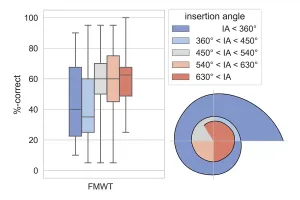What will my cochlear implant sound like?
Since the first cochlear implantation in 1977, CI technology has evolved – together with it, the speech understanding and sound quality with CI. Current studies simulate the sound of cochlear implants.

Experts know from practical experience that most CI candidates have two main questions: first, “How well will I be able to hear?” and second “How will it sound?" [1] The answer to the question of achievable speech intelligibility is not easy. There are too many influencing factors that play a role. However, we can at least measure speech intelligibility and then express it in numerical values. We can only describe the sound with more or less flowery words or compare it with known sound images.
The renowned developmental psychologist Michael F. Dorman, Professor Emeritus of Linguistics, Hearing and Speech Sciences, has been tackling these challenging issues from a scientific perspective for several decades. He first investigated the influence of various technical factors on speech comprehension with cochlear implants in different research groups. He explains the possibilities that he is now using to investigate the sound of cochlear implants: “Single-sided deaf CI patients have opened a window for researchers to answer the question that almost every CI candidate asks: 'What will my CI sound like?”"[2]
The results of his most recent studies [3] [4]are encouraging: for users of CIs with short electrodes, the CI sounds more high-pitched than natural hearing. However, for some CI users with long CI electrodes, the CI sounds almost or even completely identical to natural hearing, while others perceive the sound of the CI as more or less muffled, sometimes also less clear than natural hearing in the other ear.[5]
"Looking for a Mickey Mouse" - describe or compare sound images
One of the pioneers of such comparative studies was Sandra Prentiss with her scientific colleagues in the USA. They worked with a CI user in whom the CI electrode covers almost the full two turns of the cochlea, whereby his residual hearing was preserved almost unchanged in all pitches after implantation. Ten years ago, as part of a case study, the scientific team asked this user to compare the pitch perception with the CI with that of the natural residual hearing in the same ear. The results confirmed the assignment of individual pitches to specific locations in the cochlea and thus the importance of long electrodes. For low-pitched sounds, it also showed the effect of temporal resolution on pitch perception, thus confirming the effectiveness of so-called fine structure coding. However, this case study does not provide any information about the sound image.

Weller and his colleagues show: CI users whose electrodes are inserted more than 630 degrees show the best speech understanding, while those with electrodes inserted less than 360 degrees show significantly poorer speech understanding. ©adaptiert von Weller et al. 2023
This question was then addressed by the US scientist Michael F. Dorman together with other fellow scientists in several studies with unilaterally implanted CI users with normal, natural hearing on the other side. The CI implantations in patients with unilateral deafness were first carried out in 2003 as part of one European study and today are routine in many countries, including Austria [6]. Initially, some experts doubted whether the artificially generated sound impression of the CI was compatible with the natural sound impression on the other side. However, Dorman and his colleagues asked such bimodal CI users to precisely compare the sound of the CI with natural hearing on the other side. They used a few short sentences as an acoustic signal. These were then technically processed for the naturally hearing ear until the study participants described the sound the same as the unprocessed sound of the CI.
In the introduction to one of the resulting publications, the scientists write that they had expected Mickey Mouse or robot sounds from the simulations developed in this way. These are the images that some people still use today to describe the sound of a cochlear implant when candidates or interested parties ask about it. However, the sound of modern CIs is apparently far more natural than previously assumed! According to Dorman, the speech signal of the simulation sounds were predominantly slightly muffled [7] [8]. Some study participants even rated the sound of the CI as completely identical to the natural sound in the other ear - this was specifically the case for some users of MED-EL implants with long electrodes.
Simulation shows: Modern CIs sound natural!
Scientists have developed various simulations to make the effects of technical parameters understandable. However, this has always been just a matter of comparison: long to short electrodes, more or less frequency bands, with or without fine structure information. This is important information not only for development teams: CI candidates can use these simulations to decide which CI features they want to pay particular attention to. However, these simulations cannot give an impression of the actual sound of a cochlear implant!
The new simulations by CI expert Michael F. Dorman and his colleagues aim to do exactly that. In their explanations, they also point out

While MED-EL FLEX24 electrode arrays are used in EAS systems for people who can still hear low-pitched sounds with their natural hearing, the longest electrodes from some other providers are even shorter than that for candidates with profound hearing loss. [11]
Electrode length: how technical features affect sound
Scientists were quick to develop sound examples to help people with normal hearing to visualize the influence of individual technical features of cochlear implants, particularly the influence of electrode length. The human inner ear uses “place coding”: different pitches are assigned to specific places in the cochlea. With a cochlear implant, exactly those sound ranges are audible whose equivalent reaches the CI electrode within the cochlea. Therefore, it is particularly important that the length of the electrode is matched as closely as possible to the length of the cochlea. For CI candidates or users with a typical cochlea, the Austrian manufacturer MED-EL is the only one who offers electrodes that are long enough at 32 millimeters to reach the places for high and low tones equally.
For instance, an electrode that is just 24 millimetres long leaves over three octaves of the frequency range in a typical cochlea unreached! To make all pitches audible despite this, manufacturers use tricks called frequency shifting and frequency compression. With frequency shifting, the sound with a frequency of 70 hertz is stimulated where 590 hertz was originally heard. Due to this, everything sounds more high-pitched and this is known as the Mickey Mouse effect. With the additional frequency compression, seven octaves of audible sound are squeezed into four octaves. If this were to be replicated on a piano, the piano would not only sound unpleasantly high, but also very out of tune - so, we have to assume that this is also the effect achieved with the CI.
Moreover, a shorter electrode does not only affect the sound, but it also impairs speech comprehension. Numerous scientists have demonstrated this - most recently Tobias Weller and his colleagues at Hanover University Hospital. They say that “The benefit [of a cochlear implant] is significantly higher with an insertion angle [of the electrode] of 540° - 630° than with an insertion angle of less than 360°, although there is no significant decrease after 630°.” [10]
[1] Dorman MF, Natale SC, Baxter L, et al. Approximations to the Voice of a Cochlear Implant: Explorations With Single-Sided Deaf Listeners. Trends in Hearing. 2020;24. doi:10.1177/2331216520920079
[2] Zeitler DM, Dorman MF, Cochlear Implantation for Single-Sided Deafness: A New Treatment Paradigm. J Neurol Surg B Skull Base 2019; 80(02): 178-186. doi: 10.1055/s-0038-1677482
[3] Dorman MF, Natale SC, Butts AM, Zeitler DM, Carlson ML. The sound quality of cochlear implants: Studies with singlesided deaf patients. Otol Neurotol. 2017 Sep;38(8):e268-e273. doi: 10.1097/MAO.0000000000001449.
[4] Dorman MF, Natale SC, Zeitler DM, Baxter L, Noble JH. Looking for Mickey Mouse™ But Finding a Munchkin: The Perceptual Effects of Frequency Upshifts for Single-Sided Deaf, Cochlear Implant Patients. J Speech Lang Hear Res. 2019 Sep 20;62(9):3493-3499. doi: 10.1044/2019_JSLHR-H-18-0389. Epub 2019 Aug 15.
[5] Dorman MF, 2020
[6] Prentiss S, Staecker H, Wolford B. Ipsilateral acoustic electric pitch matching: a case study of cochlear implantation in an up-sloping hearing loss with preserved hearing across multiple frequencies. Cochlear Implants Int. 2014;15(3):161-165. doi:10.1179/1754762814Y.0000000066
[7] Dorman MF 2020
[8] Dorman MF 2019
[9] Dorman MF, Natale SC, Noble JH and Zeitler DM (2022) Upward Shifts in the Internal Representation of Frequency Can Persist Over a 3-Year Period for Cochlear Implant Patients Fit With a Relatively Short Electrode Array. Front. Hum. Neurosci. 16:863891. doi: 10.3389/fnhum.2022.863891
[10] „9 Gründe für die Relevanz der CI-Elektrode“, https://blog.medel.pro/de/chirurgie/relevanz-der-ci-elektrode/
[11] Quellen: Elektroden-Einführwinkel laut Studien siehe blog.medel.pro; Flex34 approximiert.






